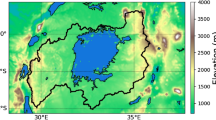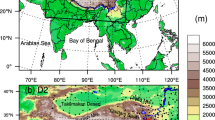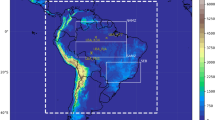Abstract
This study examines the effects of modeled planetary boundary layer (PBL) mixing on the simulated temperature diurnal cycle climatology over land in 20 CMIP5 models with AMIP simulations. When compared with observations, the magnitude of diurnal temperature range (DTR) is systematically underestimated over almost all land areas due to a widespread warm bias of daily minimum temperature (Tmin) and mostly a cold bias of daily maximum temperature (Tmax). Analyses of the CMIP5 multi-model ensemble means suggest that the biases of the simulated PBL mixing could very likely contribute to the temperature biases. For the regions with the cold bias in Tmax, the daytime PBL mixing is generally underestimated. The consequent more dry air entrainment from the free atmosphere could help maintain the surface humidity gradient, and thus produce more surface evaporation and potentially lower the Tmax. The opposite situation holds true for the regions with the warm bias of Tmax. This mechanism could be particularly applicable to the regions with moderate and wet climate conditions where surface evaporation depends more on the surface humidity gradient, but less on the available soil moisture. For the widespread warm bias of Tmin, the widely-recognized overestimated PBL mixing at nighttime should play a dominant role by transferring more heat from the atmosphere to the near-surface to warm the Tmin. Further analyses using the high resolution CFMIP2 output also support the CMIP5 results about the connections of the biases between the simulated turbulent mixing and the temperature diurnal cycle. The large inter-model variations of the simulated temperature diurnal cycle primarily appear over the arid and semi-arid regions and boreal arctic regions where the model differences in the PBL turbulence mixing could make equally significant contributions to the inter-model variations of DTR, Tmax and Tmin compared to the model differences in surface radiative processes. These results highlight the importance and need for accurate descriptions of the PBL processes with respect to the turbulent mixing in order to improve the temperature diurnal cycle simulations in climate models.










Similar content being viewed by others
References
Betts AK (2004) Understanding hydrometeorology using global models. Bull Am Meteorol Soc 85:1673–1688. doi:10.1175/BAMS-85-11-1673
Betts AK, Barr AG (1996) First international satellite land surface climatology field experiment 1987 sonde budget revisited. J Geophys Res Atmos 101:23285–23288. doi:10.1029/96JD02247
Bonan GB (2001) Observational evidence for reduction of daily maximum temperature by croplands in the Midwest United States. J Clim 14:2430–2442. doi:10.1175/1520-0442(2001)
Bonan GB, Oleson KW, Vertenstein M, Levis S, Zeng XB, Dai YJ, Dickinson RE, Yang ZL (2002) The land surface climatology of the community land model coupled to the NCAR Community Climate Model. J Clim 15:3123–3149. doi:10.1175/1520-0442(2002)
Bosveld FC et al (2014) The third GABLS intercomparison case for evaluation studies of boundary-layer models. Part B: results and process understanding. Bound Layer Meteorol 152:157–187. doi:10.1007/s10546-014-9919-1
Cattiaux J, Douville H, Peings Y (2013) European temperatures in CMIP5: origins of present-day biases and future uncertainties. Clim Dyn 41:2889–2907. doi:10.1007/s00382-013-1731-y
Collatz GJ, Bounoua L, Los SO, Randall DA, Fung IY, Sellers PJ (2000) A mechanism for influence of vegetation on the response of the diurnal temperature range to changing climate. Geophys Res Lett 27:3381–3384. doi:10.1029/1999GL010947
Cuxart J et al (2006) Single-column model intercomparison for a stably stratified atmospheric boundary layer. Bound Layer Meteorol 118(2):273–303. doi:10.1007/s10546-005-3780-1
Dai AG, Trenberth KE, Karl TR (1999) Effects of clouds, soil moisture, precipitation, and water vapor on diurnal temperature range. J Clim 12:2451–2473. doi:10.1175/1520-0442(1999)
Davy R, Esau I (2014a) Surface air temperature variability in global climate models. Atmos Sci Lett 15:13–20. doi:10.1002/asl2.456
Davy R, Esau I (2014b) Global climate models’ bias in surface temperature trends and variability. Environ Res Lett 9:114024. doi:10.1088/1748-9326/9/11/114024
Davy R, Esau I, Chernokulsky A, Outten S, Zilitinkevich S (2016) Diurnal asymmetry to the observed global warming. Int J Climatol. doi:10.1002/joc.4688
Decker M, Brunke MA, Wang Z, Sakaguchi K, Zeng X, Bosilovich MG (2012) Evaluation of the reanalysis products from GSFC, NCEP, and ECMWF using flux tower observations. J Clim 25:1916–1944. doi:10.1175/JCLI-D-11-00004.1
Dee DP et al (2011) The ERA-Interim reanalysis: configuration and performance of the data assimilation system. Q J R Meteorol Soc 137:553–597. doi:10.1002/qj.828
Dirmeyer PA, Jin Y, Singh B, Yan XQ (2013) Trends in land–atmosphere interactions from CMIP5 simulations. J Hydrometeorol 14:829–849. doi:10.1175/JHM-D-12-0107.1
Dirmeyer PA, Wang Z, Mbuh MJ, Norton HE (2014) Intensified land surface control on boundary layer growth in a changing climate. Geophys Res Lett 41:1290–1294. doi:10.1002/2013GL058826
Engeln AV, Teixeira J (2013) A planetary boundary layer height climatology derived from ECMWF reanalysis data. J Clim 26:6575–6590. doi:10.1175/JCLI-D-12-00385.1
Esau I, Ziltinkevich S (2010) On the role of the planetary boundary layer depth in the climate system. Adv Sci Res 4:63–69. doi:10.5194/asr-4-63-2010
Esau I, Davy R, Outten S (2012) Complementary explanation of temperature response in the lower atmosphere. Environ Res Lett 7:044026. doi:10.1088/1748-9326/7/4/044026
Gallo KP, Easterling DR, Peterson TC (1996) The influence of land use/land cover on climatological values of the diurnal temperature range. J Clim 9:2941–2944. doi:10.1175/1520-0442(1996)
Gentine P, Entekhabi D, Polcher J (2011) The diurnal behavior of evaporative fraction in the soil–vegetation–atmospheric boundary layer continuum. J Hydrometeorol 12:1530–1546. doi:10.1175/2011JHM1261.1
Hoerling M, Eischeid J, Perlwitz J (2010) Regional precipitation trends: distinguishing natural variability from anthropogenic forcing. J Clim 23:2131–2145. doi:10.1175/2009JCLI3420.1
Holtslag AAM, Steeneveld GJ, van deWiel BJH (2007) Role of land-surface temperature feedback on model performance for the stable boundary layer. Bound Layer Meteorol 125:361–376. doi:10.1007/s10546-007-9214-5
Holtslag AAM et al (2013) Stable atmospheric boundary layers and diurnal cycles: challenges for weather and climate models. Bull Am Meteorol Soc 94:1691–1706. doi:10.1175/BAMS-D-11-00187.1
Hu X, Nielsen-Gammon JW, Zhang F (2010) Evaluation of three planetary boundary layer schemes in the WRF model. J Appl Meteorol Climatol 49:1831–1844. doi:10.1175/2010JAMC2432.1
Hua WJ, Chen HS, Zhu SG, Sun SL, Yu M, Zhou L (2013) Hotspots of the sensitivity of the land surface hydrological cycle to climate change. Chin Sci Bull 58(30):3682–3688. doi:10.1007/s11434-013-5846-7
Hua WJ, Chen HS, Sun SL (2014) Uncertainty in land surface temperature simulation over China by CMIP3/CMIP5 models. Theor Appl Climatol 117(3–4):463–474. doi:10.1007/s00704-013-1020-z
IPCC (2007) Climate change 2007: the physical science basis, contribution of Working Group I to the Fourth Assessment Report of the IPCC. Cambridge University Press, Cambridge. ISBN:978-0-521-88009-1
IPCC (2013) Climate change 2013: the physical science basis, the contribution of Working Group I to the Fifth Assessment Report of the Intergovernmental Panel on Climate Change. Cambridge University Press, Cambridge. ISBN:978-1-107-05799-1
Kharin VV, Zwiers FW, Zhang XB, Hegerl GC (2007) Changes in temperature and precipitation extremes in the IPCC ensemble of global coupled model simulations. J Clim 20:1419–1444. doi:10.1175/JCLI4066.1
Kleczek MA, Steeneveld GJ, Holtslag AAM (2014) Evaluation of the weather research and forecasting mesoscale model for GABLS3: impact of boundary-layer schemes, boundary conditions and spin-up. Bound Layer Meteorol 152:213–243. doi:10.1007/s10546-014-9925-3
Koster RD et al (2004) Regions of coupling between soil moisture and precipitation. Science 305:1138–1140. doi:10.1126/science.1100217
Lewis SC, Karoly DJ (2013) Evaluation of historical diurnal temperature range trends in CMIP5 models. J Clim 26:9077–9089. doi:10.1175/JCLI-D-13-00032.1
Lindvall J, Svensson G (2015) The diurnal temperature range in the CMIP5 models. Clim Dyn 44:405–421. doi:10.1007/s00382-014-2144-2
Lindvall J, Svensson G, Hannay C (2013) Evaluation of near-surface parameters in the two versions of the atmospheric model in cesm1 using flux station observations. J Clim 26:26–44. doi:10.1175/JCLI-D-12-00020.1
Liu S, Liang XZ (2010) Observed diurnal cycle climatology of planetary boundary layer height. J Clim 23:5790–5809. doi:10.1175/2010JCLI3552.1
Lobell DB, Bonfils C, Duffy PB (2007) Climate change uncertainty for daily minimum and maximum temperatures: a model inter-comparison. Geophys Res Lett 34:L05715. doi:10.1029/2006GL028726
Mitchel TD, Jones PD (2005) An improved method of constructing a database of monthly climate observations and associated high-resolution grids. Int J Climatol 25:693–712. doi:10.1002/joc.1181
Perkins SE, Pitman AJ, Holbrook NJ, McAneney J (2007) Evaluation of the AR4 climate models’ simulated daily maximum temperature, minimum temperature, and precipitation over Australia using probability density functions. J Clim 20:4356–4376. doi:10.1175/JCLI4253.1
Pithan F, Angevine W, Mauritsen T (2015) Improving a global model from the boundary layer: total turbulent energy and the neutral limit Prandtl number. J Adv Model Earth Syst 7:791–805. doi:10.1002/2014MS000382
Rutan DA, Kato S, Doelling DR, Rose FG, Loeb N, Caldwell T, Nguyen LTC (2014) Validation of surface irradiance calculated in NASA’s clouds and the earth radiant energy system (CERES) SYN and EBAF data products. In: Papers from 14th AMS conference on atmospheric radiation. https://ams.confex.com/ams/14CLOUD14ATRAD/webprogram/Paper249853.html
Sandu I, Beljaars A, Bechtold P, Mauritsen T, Balsamo G (2013) Why is it so difficult to represent stably stratified conditions in numerical weather prediction (NWP) models? J Adv Model Earth Syst 5:117–133. doi:10.1002/jame.20013
Scheff J, Frierson DMW (2015) Terrestrial aridity and its response to greenhouse warming across CMIP5 climate models. J Clim 28:5583–5600. doi:10.1175/JCLI-D-14-00480.1
Seidel DJ, Zhang Y, Beljaars A, Golaz J-C, Jacobson AR, Medeiros B (2012) Climatology of the planetary boundary layer over the continental United States and Europe. J Geophys Res 117:D17106. doi:10.1029/2012JD018143
Shao Y, Ishizuka M, Mikami M, Leys JF (2011) Parameterization of size-resolved dust emission and validation with measurements. J Geophys Res 116:D08203. doi:10.1029/2010JD014527
Shin HH, Hong S (2011) Intercomparison of planetary boundary-layer parametrizations in the WRF model for a single day from CASES-99. Bound Layer Meteorol 139:261–281. doi:10.1007/s10546-010-9583-z
Sillmann J, Kharin VV, Zhang X, Zwiers FW, Bronaugh D (2013) Climate extremes indices in the CMIP5 multi-model ensemble: part 1. Model evaluation in the present climate. J Geophys Res Atmos 118:1716–1733. doi:10.1002/jgrd.50203
Simmons AJ, Willett KM, Jones PD, Thorne PW, Dee DP (2010) Low-frequency variations in surface atmospheric humidity, temperature, and precipitation: inferences from reanalyses and monthly gridded observational data sets. J Geophys Res 115:D01110. doi:10.1029/2009JD012442
Steeneveld GJ, Mauritsen T, de Bruijn EIF, Vila-Guerau de Arellano J, Svensson G, Holtslag AAM (2008) Evaluation of limited area models for the representation of the diurnal cycle and contrasting nights in CASES99. J Appl Meteorol Climatol 47:869–887. doi:10.1175/2007JAMC1702.1
Sterk HAM, Steeneveld GJ, Holtslag AAM (2013) The role of snow-surface coupling, radiation, and turbulent mixing in modeling a stable boundary layer over Arctic sea ice. J Geophys Res Atmos 118:1199–1217. doi:10.1002/jgrd.50158
Svensson G, Lindvall J (2015) Evaluation of near-surface variables and the vertical structure of the boundary layer in CMIP5 models. J Clim 28:5233–5253. doi:10.1175/JCLI-D-14-00596.1
Svensson G et al (2011) Evaluation of the diurnal cycle in the atmospheric boundary layer over land as represented by a variety of single-column models: the second GABLS experiment. Bound Layer Meteorol 140:177–206. doi:10.1007/s10546-011-9611-7
Van Heerwaarden CC, Vilà-Guerau de Arellano J, Moene AF, Holtslag AAM (2009) Interactions between dry-air entrainment, surface evaporation and convective boundary-layer development. Q J R Meteorol Soc 135:1277–1291. doi:10.1002/qj.431
Viterbo P, Beljaars A, Mahfouf J-F, Teixeira J (1999) The representation of soil moisture freezing and its impact on the stable boundary layer. Q J R Meteorol Soc 125:2401–2426. doi:10.1002/qj.49712555904
Vogelezang DHP, Holtslag AAM (1996) Evaluation and model impacts of alternative boundary-layer height formulations. Bound Layer Meteorol 81:245–269. doi:10.1007/BF02430331
Wang K, Dickinson RE (2013) Global atmospheric downward longwave radiation at the surface from ground-based observations, satellite retrievals, and reanalyses. Rev Geophys 51:150–185. doi:10.1002/rog.20009
Wang AH, Zeng XB (2013) Development of global hourly 0.5° land surface air temperature datasets. J Clim 26:7676–7691. doi:10.1175/JCLI-D-12-00682.1
Wang AH, Zeng XB (2014) Range of monthly mean hourly land surface air temperature diurnal cycle over high northern latitudes. J Geophys Res Atmos 119:5836–5844. doi:10.1002/2014JD021602
Wild M (2009) How well do IPCC-AR4/CMIP3 climate models simulate global dimming/brightening and twentieth-century daytime and nighttime warming? J Geophys Res 114:D00D11. doi:10.1029/2008JD011372
Willmott CJ (1984) On the evaluation of model performance in physical geography. In: Gaile GL, Willmott CJ (eds) Spatial statistics and models. Springer, Dordrecht. ISBN:978-90-481-8385-2
Xie S et al (2010) Clouds and more: ARM climate modeling best estimate data. Bull Am Meteorol Soc 91:13–20. doi:10.1175/2009BAMS2891.1
Yi C et al (2010) Climate control of terrestrial carbon exchange across biomes and continents. Environ Res Lett 5:034007. doi:10.1088/1748-9326/5/3/034007
Zhang D, Zheng W (2004) Diurnal cycles of surface winds and temperatures as simulated by five boundary layer parameterizations. J Appl Meteorol 43:157–169. doi:10.1175/1520-0450
Zhang JY, Wang WC, Wu LY (2009) Land–atmosphere coupling and diurnal temperature range over the contiguous United States. Geophys Res Lett 36:L06706. doi:10.1029/2009GL037505
Zhang X, Liang S, Wang G, Yao Y, Jiang B, Cheng J (2016) Evaluation of the reanalysis surface incident shortwave radiation products from NCEP, ECMWF, GSFC, and JMA using satellite and surface observations. Remote Sens 8:225. doi:10.3390/rs8030225
Zhou L, Dickinson RE, Tian Y, Vose RS, Dai YJ (2007) Impact of vegetation removal and soil aridation on diurnal temperature range in a semiarid region: application to the Sahel. Proc Natl Acad Sci USA 104:17937–17942. doi:10.1073/pnas.0700290104
Zhou L, Dickinson RE, Dirmeyer P, Chen HS, Dai YJ, Tian Y (2008) Asymmetric response of maximum and minimum temperatures to soil emissivity change over the Northern African Sahel in a GCM. Geophys Res Lett 35:L05402. doi:10.1029/2007GL032953
Zhou L, Dai AG, Dai YJ, Vose RS, Zou CZ, Tian Y, Chen HS (2009a) Spatial dependence of diurnal temperature range trends on precipitation from 1950 to 2004. Clim Dyn 32:429–440. doi:10.1007/s00382-008-0387-5
Zhou L, Dickinson RE, Dirmeyer P, Dai A, Min SK (2009b) Spatiotemporal patterns of changes in maximum and minimum temperatures in multi-model simulations. Geophys Res Lett 36:L02702. doi:10.1029/2008GL036141
Zhou L, Dickinson RE, Dai A, Dirmeyer P (2010) Detection and attribution of anthropogenic forcing to diurnal temperature range changes from 1950 to 1999: comparing multi-model simulations with observations. Clim Dyn 35:1289–1307. doi:10.1007/s00382-009-0644-2
Acknowledgments
The authors wish to thank three anonymous reviewers for their useful suggestions that have remarkably improved the quality of this work. We thank the World Climate Research Program (WCRP) Working Group on Coupled Modelling, which is responsible for CMIP, and the climate modeling groups for making their model output available through the US Department of Energy’s Program for Climate Model Diagnosis and Inter-comparison (PCMDI). Also thanks to Jones, P.D. and Harris, I. at the University of East Anglia for providing the CRU TS3.23 dataset (http://browse.ceda.ac.uk/browse/badc/cru/data/cru_ts/cru_ts_3.23), Xie, S. and his team for providing the ARMBE dataset (http://www.arm.gov/data/vaps/armbe), the European Centre for Medium-Range Weather Forecasts for providing the ECMWF Interim reanalysis data, the NASA Langley Research Center for providing the CERES-EBAF dataset (https://ceres-tool.larc.nasa.gov/ord-tool/jsp/EBAFSFCSelection.jsp), and the WCRP and the Global Energy and Water Cycle Experiment (GEWEX) which are responsible for the GPCP dataset. This work was supported by the China Scholarship Council (CSC) and by the University at Albany, State University of New York.
Author information
Authors and Affiliations
Corresponding author
Electronic supplementary material
Below is the link to the electronic supplementary material.
Rights and permissions
About this article
Cite this article
Wei, N., Zhou, L. & Dai, Y. Evaluation of simulated climatological diurnal temperature range in CMIP5 models from the perspective of planetary boundary layer turbulent mixing. Clim Dyn 49, 1–22 (2017). https://doi.org/10.1007/s00382-016-3323-0
Received:
Accepted:
Published:
Issue Date:
DOI: https://doi.org/10.1007/s00382-016-3323-0




